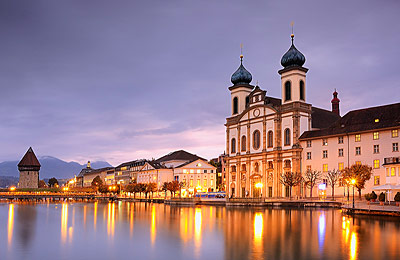 Image #1 … Lucerne Dawn … Image #1 … Lucerne Dawn … Our group landed in Zurich where we boarded our motor coach and headed for Lucerne in the heart of Switzerland. I used a slow shutter speed of 30 seconds for this image of the Jesuit Church of Lucerne. This long exposure allowed the river water to have an almost icy appearance. I also used a FORMATT #9 (3 stop, soft transition) Graduated Neutral Density Filter (GNDF). This is a glass filter that I often hand hold in front of the lens. Sometimes I use a Coken Filter Holder, but it is rare. Using the GNDF helped darken, or diminish the exposure on the early morning sky thus giving a more dramatic feel to the scene. The bottom half of the filter is clear and allows the street light exposure to look perfect. Nikon D3s, ISO400, 30 seconds at f22, Nikon 28-300mm VR Zoom Lens, WB 4000K, SanDisk 32G Extreme Pro Flash Card. |
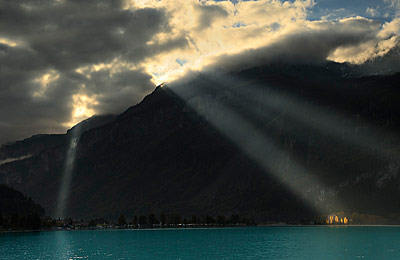
Image #2 … Breinz Light … Our next base city was Interlaken just a half day coach ride to the Southwest. We made some nice pictures along the way and arrived in time for late day sun and pictures of the charming town at sunset. The following morning took us to the small town of Breinz. I was first off the motor coach and was greeted with this extraordinary scene. Everyone hurried out and we all made some beautiful images of the heavenly rays illuminating fall colors across the teal colored lake. No Tripod used just hand held the camera and again I used my GNDF to reduce the exposure of the sun breaking through the clouds but not darken the rays. Nikon D3s, ISO800, 1/800 at f11, Nikon 28-300mm VR Zoom Lens, WB 5500K, SanDisk 32G Extreme Pro Flash Card. |
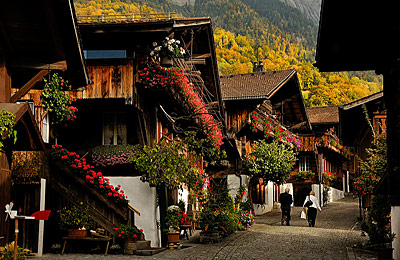 Image #3 … Breinz Stroll … Image #3 … Breinz Stroll … Further exploration of the town revealed a beautiful section of old “Chalet” style homes. This architecture is wide spread throughout Switzerland. I spoke to my group of “Trekkers” about manual exposure and encouraged them to “expose for the light”. This example was made just as the couple walked through a shaft of sunlight. I am not so concerned about the shadow areas but suggested to the group to dial down the contrast setting in their camera so the shadows don’t fall completely to black. Nikon D3s, ISO500, 1/1000 at f16, Nikon 28-300mm VR Zoom Lens, WB 5500K, SanDisk 32G Extreme Pro Flash Card. |
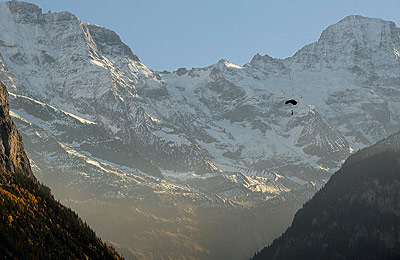 Image #4 … Swiss Soaring … Next stop was the Lauterbrunnen region and the town of Wengen. We rode the cog train up to this beautiful alpine town, made some breathtaking scenics, and headed down at sunset. It is my custom to make pictures when I see something interesting, even out of moving cars, busses, airplanes, boats, and in this case a cog train. This parachutist floating across the mountainous backdrop was a fleeting moment that a couple of Trekkers and I noticed as the cog train emerged from the trees for only a split second. If it attracts your attention, make a picture. Nikon D3s, ISO1000, 1/500 at f18, Nikon 28-300mm VR Zoom Lens, WB 6700K, GNDF, SanDisk 32G Extreme Pro Flash Card. Image #4 … Swiss Soaring … Next stop was the Lauterbrunnen region and the town of Wengen. We rode the cog train up to this beautiful alpine town, made some breathtaking scenics, and headed down at sunset. It is my custom to make pictures when I see something interesting, even out of moving cars, busses, airplanes, boats, and in this case a cog train. This parachutist floating across the mountainous backdrop was a fleeting moment that a couple of Trekkers and I noticed as the cog train emerged from the trees for only a split second. If it attracts your attention, make a picture. Nikon D3s, ISO1000, 1/500 at f18, Nikon 28-300mm VR Zoom Lens, WB 6700K, GNDF, SanDisk 32G Extreme Pro Flash Card. |
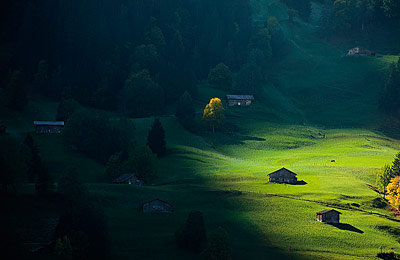 Image #5 … Grindelwald Light … The next day placed us in the Jungfrau Region and the town of Grindelwald. This is the home of the “top of Europe” and the Eiger in the Bernese Alps. “Light is the greatest influence” as the shadow of the Eiger looms across the inhabitants of Grindelwald. Nikon D3s, ISO500, 1/500, f9, Nikon 28-300mm VR Zoom Lens, WB 6700K, SanDisk 32G Extreme Pro Flash Card. Image #5 … Grindelwald Light … The next day placed us in the Jungfrau Region and the town of Grindelwald. This is the home of the “top of Europe” and the Eiger in the Bernese Alps. “Light is the greatest influence” as the shadow of the Eiger looms across the inhabitants of Grindelwald. Nikon D3s, ISO500, 1/500, f9, Nikon 28-300mm VR Zoom Lens, WB 6700K, SanDisk 32G Extreme Pro Flash Card. |
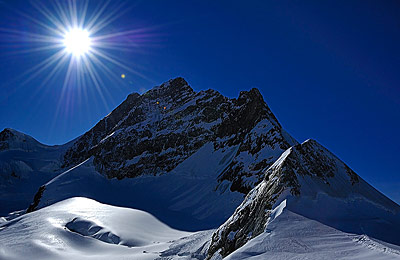 Image #6 … Top of Europe … What took Clint Eastwood 2 days to climb in the movie “The Eiger Sanction” took only an hour by train for our Trekkers. The train climbs the Eiger mostly from within the massive mountain. We emerged at the “Top of Europe” where there are observation decks with access to the frozen landscape. Because I am facing directly into the sun, a Polarizing Filter would be ineffective. I again used my GNDF to darken the sky but retain a usable exposure on the lower half of the scene. The sunstar effect is created by using an aperture setting of f16 or more. Nikon D3s, ISO500, 1/1250 at f25, Nikon 28-300mm VR Zoom Lens, WB 4000K, SanDisk 32G Extreme Pro Flash Card. I used a fast shutter speed of 1/1250 because of the windy conditions and no tripod was used. Image #6 … Top of Europe … What took Clint Eastwood 2 days to climb in the movie “The Eiger Sanction” took only an hour by train for our Trekkers. The train climbs the Eiger mostly from within the massive mountain. We emerged at the “Top of Europe” where there are observation decks with access to the frozen landscape. Because I am facing directly into the sun, a Polarizing Filter would be ineffective. I again used my GNDF to darken the sky but retain a usable exposure on the lower half of the scene. The sunstar effect is created by using an aperture setting of f16 or more. Nikon D3s, ISO500, 1/1250 at f25, Nikon 28-300mm VR Zoom Lens, WB 4000K, SanDisk 32G Extreme Pro Flash Card. I used a fast shutter speed of 1/1250 because of the windy conditions and no tripod was used. |
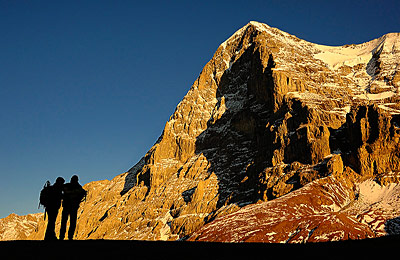 Image #7 … Climbers Light … At the midway point on the train route we changed stations before continuing the decent to Grindelwald. Many Trekkers made a quick 20 minute hike to this vantage point where climbers stepped into the shadow of the Eiger’s peak and became silhouetted against a lower sunlit portion of the Eiger. Nikon D3s, ISO1000, 1/500 at f14, Nikon 28-300mm VR Zoom Lens, WB 7400K, SanDisk 32G Extreme Pro Flash Card. Image #7 … Climbers Light … At the midway point on the train route we changed stations before continuing the decent to Grindelwald. Many Trekkers made a quick 20 minute hike to this vantage point where climbers stepped into the shadow of the Eiger’s peak and became silhouetted against a lower sunlit portion of the Eiger. Nikon D3s, ISO1000, 1/500 at f14, Nikon 28-300mm VR Zoom Lens, WB 7400K, SanDisk 32G Extreme Pro Flash Card. |
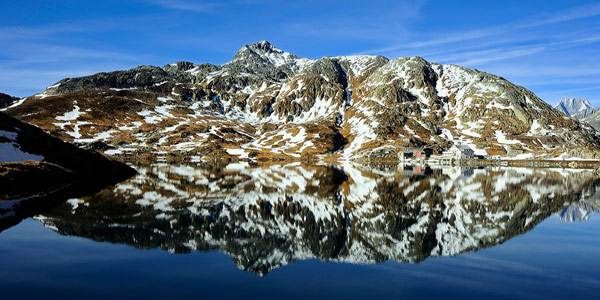 Image #8 … Grimsel Pass Reflection … On the road again the following morning and our destination was Zermatt. This was a good day of riding in the motor coach and we made several stops along the day’s excursion. This, almost unrealistic reflection is at the top of Grimsel Pass. I made 7 vertical images, slightly overlapping each one, and merged them in Photoshop to create this mega file Panorama. I again used my GNDF, but this time I mounted it into the Cokin Filter Holder so that the reduction of sky exposure in each of the 7 images is consistent. Nikon D3s, ISO500, 1/500 at f16, Nikon 28-300mm VR Zoom Lens, WB 4700K, GNDF and Cokin Filter Holder, Gitzo Carbon Fiber Tripod, SanDisk 32G Extreme Pro Flash Card. Image #8 … Grimsel Pass Reflection … On the road again the following morning and our destination was Zermatt. This was a good day of riding in the motor coach and we made several stops along the day’s excursion. This, almost unrealistic reflection is at the top of Grimsel Pass. I made 7 vertical images, slightly overlapping each one, and merged them in Photoshop to create this mega file Panorama. I again used my GNDF, but this time I mounted it into the Cokin Filter Holder so that the reduction of sky exposure in each of the 7 images is consistent. Nikon D3s, ISO500, 1/500 at f16, Nikon 28-300mm VR Zoom Lens, WB 4700K, GNDF and Cokin Filter Holder, Gitzo Carbon Fiber Tripod, SanDisk 32G Extreme Pro Flash Card. |
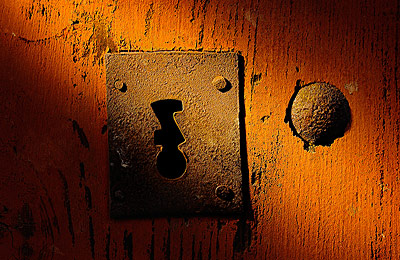 Image #9 … Key Hole Light … At the bottom of Grimsel Pass and about a 45minute drive South we reached the town of Ulrichen. This small village consisted of a couple of dozen homes of which the oldest was built in 1602. Each day I would encourage the Trekkers to look for the light. Sometimes a shaft of sunlight happens to fall perfectly on your subject, but sometimes I make my own shaft of light. I found this old keyhole on the shady side of the building. I used my Inova BOLT 2L Flashlight ( www.inovalight.com) and made my own shaft of light right were I wanted it. By the end of the Trek I saw many Trekkers making use of this same technique. Nikon D3s, ISO1000, 1/200 at f8, Nikon 28-300mm VR Zoom Lens, WB 8400K, SanDisk 32G Extreme Pro Flash Card. Image #9 … Key Hole Light … At the bottom of Grimsel Pass and about a 45minute drive South we reached the town of Ulrichen. This small village consisted of a couple of dozen homes of which the oldest was built in 1602. Each day I would encourage the Trekkers to look for the light. Sometimes a shaft of sunlight happens to fall perfectly on your subject, but sometimes I make my own shaft of light. I found this old keyhole on the shady side of the building. I used my Inova BOLT 2L Flashlight ( www.inovalight.com) and made my own shaft of light right were I wanted it. By the end of the Trek I saw many Trekkers making use of this same technique. Nikon D3s, ISO1000, 1/200 at f8, Nikon 28-300mm VR Zoom Lens, WB 8400K, SanDisk 32G Extreme Pro Flash Card. |
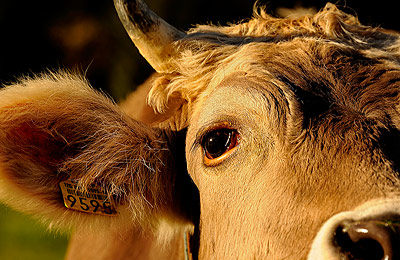 Image #10 … Elsie the Cow … We are still traveling to Zermatt which is near the southern border of Switzerland. The Trekkers wanted to photograph some cows as they were a part of the Swiss economic landscape, and so Reed and I said we would stop for sunshine cow…”no sun, no cow.” Well, here’s Elsie. Nikon D3s, ISO1000, 1/1000 at f10, Nikon 28-300mm VR Zoom Lens, WB 6700K, SanDisk 32G Extreme Pro Flash Card. I think I might be the oldest on the trek as no one even recognized the name Elsie the Cow from the Borden’s Dairy Company. Image #10 … Elsie the Cow … We are still traveling to Zermatt which is near the southern border of Switzerland. The Trekkers wanted to photograph some cows as they were a part of the Swiss economic landscape, and so Reed and I said we would stop for sunshine cow…”no sun, no cow.” Well, here’s Elsie. Nikon D3s, ISO1000, 1/1000 at f10, Nikon 28-300mm VR Zoom Lens, WB 6700K, SanDisk 32G Extreme Pro Flash Card. I think I might be the oldest on the trek as no one even recognized the name Elsie the Cow from the Borden’s Dairy Company. |
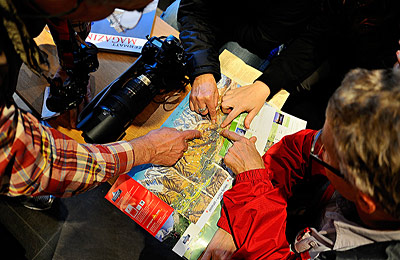 Image #11 … Swiss Direction … All roads seem to lead to the Matterhorn and Reed and I were as “excited as little boys” as our guide George would say when we arrived in Zermatt. We very much wanted the group to make a memorable image of the famed peak and so planning began as soon as we arrived at the hotel for the next day’s trek. Image #11 … Swiss Direction … All roads seem to lead to the Matterhorn and Reed and I were as “excited as little boys” as our guide George would say when we arrived in Zermatt. We very much wanted the group to make a memorable image of the famed peak and so planning began as soon as we arrived at the hotel for the next day’s trek. |
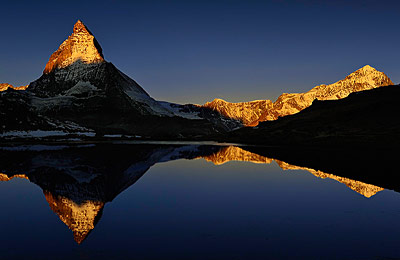 Image #12 … Matterhorn Reflection … The Matterhorn is the crown jewel of Switzerland and is in the Pennine Alps on the boarder of Switzerland and Italy. At a towering 14,692 ft. (4,478 m.) it is an iconic landscape. Reed and I determined that if we boarded the first ascending train we would arrive at the Rotenboden station (a small rock building at about 11,500 ft.) 40 minutes before sunrise. This would give our group enough time to “trek” to a small lake that might give us a reflection of the Matterhorn at sunrise. We were correct in our planning. It was a spectacular 40 minutes as we all captured some fantastic images as the sun lit up the East face of the Matterhorn and the Pennine Alps. Nikon D3s, ISO200, 1/40 at f18, Nikon 28-300mm VR Zoom Lens, GNDF to reduce some exposure in the sky and allow the reflection to be more prominent, WB 6700K, SanDisk 32G Extreme Pro Flash Card. This was a wonderful morning and an inspirational morning of gratitude for me personally. I have been privileged to photograph and experience many incredible sights and moments in my career. The Pyramids, the Great Wall, Machu Pichu to name a few are all iconic images burned into my mind and my photo archive. The Matterhorn ranks right up there with the best. It was glorious and I was excited to help others experience it and capture a memorable image for themselves. Image #12 … Matterhorn Reflection … The Matterhorn is the crown jewel of Switzerland and is in the Pennine Alps on the boarder of Switzerland and Italy. At a towering 14,692 ft. (4,478 m.) it is an iconic landscape. Reed and I determined that if we boarded the first ascending train we would arrive at the Rotenboden station (a small rock building at about 11,500 ft.) 40 minutes before sunrise. This would give our group enough time to “trek” to a small lake that might give us a reflection of the Matterhorn at sunrise. We were correct in our planning. It was a spectacular 40 minutes as we all captured some fantastic images as the sun lit up the East face of the Matterhorn and the Pennine Alps. Nikon D3s, ISO200, 1/40 at f18, Nikon 28-300mm VR Zoom Lens, GNDF to reduce some exposure in the sky and allow the reflection to be more prominent, WB 6700K, SanDisk 32G Extreme Pro Flash Card. This was a wonderful morning and an inspirational morning of gratitude for me personally. I have been privileged to photograph and experience many incredible sights and moments in my career. The Pyramids, the Great Wall, Machu Pichu to name a few are all iconic images burned into my mind and my photo archive. The Matterhorn ranks right up there with the best. It was glorious and I was excited to help others experience it and capture a memorable image for themselves. |
 Image #13 … Alpine Grazers … After sunrise our group caught the next train and continued up the Alps to Gornergrat were we made more pictures of the entire range. We began our descent by train around 10:00 am and dropped Reed and some Trekkers off at Riffelalp, and then a bit further down the mountain my group dropped off at Findelbach. Both Reed and I and our respective group of Trekkers began a walking descent down to Zermatt making pictures all along the way. Here are some alpine sheep we found grazing. Nikon D3s, ISO1000, 1/80 at f11, Nikon 28-300mm VR Zoom Lens, WB 6700K, SanDisk 32G Extreme Pro Flash Card. Image #13 … Alpine Grazers … After sunrise our group caught the next train and continued up the Alps to Gornergrat were we made more pictures of the entire range. We began our descent by train around 10:00 am and dropped Reed and some Trekkers off at Riffelalp, and then a bit further down the mountain my group dropped off at Findelbach. Both Reed and I and our respective group of Trekkers began a walking descent down to Zermatt making pictures all along the way. Here are some alpine sheep we found grazing. Nikon D3s, ISO1000, 1/80 at f11, Nikon 28-300mm VR Zoom Lens, WB 6700K, SanDisk 32G Extreme Pro Flash Card. |
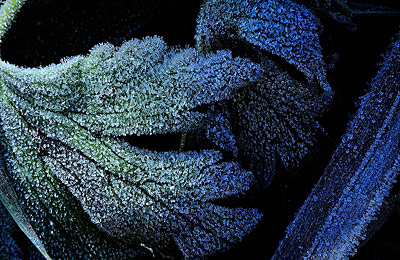 Image #14 … Swiss Frost … It is easy to be so overwhelmed by the grand landscape that the small supporting characters of the environment can escape our eye. Each day I continually promoted the exploration and image making of the small details of our trek. Nikon D3s, ISO2500, 1/250 at f18, Nikon 28-300mm VR Zoom Lens with Kenko Len Extension Tube for a close up look, WB 4000K, Inova BOLT 2L flashlight for a little shaft of light, SanDisk 32G Extreme Pro Flash Card. Image #14 … Swiss Frost … It is easy to be so overwhelmed by the grand landscape that the small supporting characters of the environment can escape our eye. Each day I continually promoted the exploration and image making of the small details of our trek. Nikon D3s, ISO2500, 1/250 at f18, Nikon 28-300mm VR Zoom Lens with Kenko Len Extension Tube for a close up look, WB 4000K, Inova BOLT 2L flashlight for a little shaft of light, SanDisk 32G Extreme Pro Flash Card. |
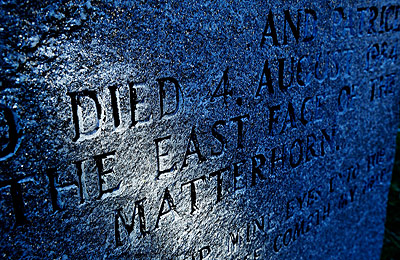 Image #15 … They Came to Climb … As we arrived back in Zermatt some of us took a photo walk through the town and discovered the Zermatt Cemetery. Among the markers were several climbing casualties of the Matterhorn. I once again used my Inova BOLT 2L flashlight to illuminate a shaft of light to draw attention to the inscription. As I explained to the Trekkers, this picture is easy to make. I simply underexpose the scene by about 1 stop or –1.0 if you are using a program mode. Then I hold the flashlight in my left hand and cast an angle of light across the subject. I can either hand hold the camera, as I did in this case, or I can use a tripod to support it. Because I am teaching during the trek I seldom use a tripod so that I make a quick example demonstration and then have the Trekkers make their own pictures. Nikon D3s, ISO2000, 1/250 at f10, Nikon 28-300mm VR Zoom Lens, WB3700K, Inova BOLT 2L flashlight, SanDisk Extreme Pro Flash Card. Image #15 … They Came to Climb … As we arrived back in Zermatt some of us took a photo walk through the town and discovered the Zermatt Cemetery. Among the markers were several climbing casualties of the Matterhorn. I once again used my Inova BOLT 2L flashlight to illuminate a shaft of light to draw attention to the inscription. As I explained to the Trekkers, this picture is easy to make. I simply underexpose the scene by about 1 stop or –1.0 if you are using a program mode. Then I hold the flashlight in my left hand and cast an angle of light across the subject. I can either hand hold the camera, as I did in this case, or I can use a tripod to support it. Because I am teaching during the trek I seldom use a tripod so that I make a quick example demonstration and then have the Trekkers make their own pictures. Nikon D3s, ISO2000, 1/250 at f10, Nikon 28-300mm VR Zoom Lens, WB3700K, Inova BOLT 2L flashlight, SanDisk Extreme Pro Flash Card. |
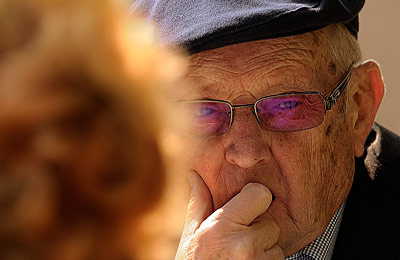 Image #16 … Italian Gaze … Our trek through Switzerland has come to an end, but we still had 2 days of photography left. Welcome to Italy. While Switzerland was all about the landscape, Italy was all about people. Stresa, Lake Como and the town of Bellagio were quite a departure from the sky scraping Alps. Nikon D3s, ISO1000, 1/500 at f8, Nikon 28-300mm VR Zoom Lens, WB 5500K, SanDisk 32G Extreme Pro Flash Card. Image #16 … Italian Gaze … Our trek through Switzerland has come to an end, but we still had 2 days of photography left. Welcome to Italy. While Switzerland was all about the landscape, Italy was all about people. Stresa, Lake Como and the town of Bellagio were quite a departure from the sky scraping Alps. Nikon D3s, ISO1000, 1/500 at f8, Nikon 28-300mm VR Zoom Lens, WB 5500K, SanDisk 32G Extreme Pro Flash Card. |
 Image #17 … Streets of Stresa … As our group wandered the colorful and narrow streets of Stresa I encouraged the trekkers to once again look for the light, color, and gesture before pressing the shutter. Nikon D3s, ISO500, 1320 at f13, Nikon 28-300mm VR Zoom Lens, WB 6700K, SanDisk Extreme Pro Flash Card. Image #17 … Streets of Stresa … As our group wandered the colorful and narrow streets of Stresa I encouraged the trekkers to once again look for the light, color, and gesture before pressing the shutter. Nikon D3s, ISO500, 1320 at f13, Nikon 28-300mm VR Zoom Lens, WB 6700K, SanDisk Extreme Pro Flash Card. |
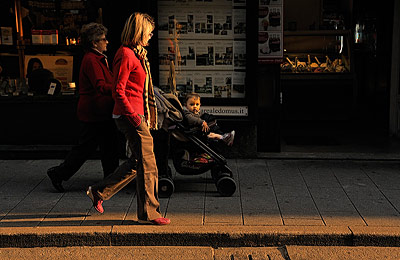 Image #18 … Streets of Como … I emphasized to the group to try and anticipate the light and a possible moment that the subject might walk into it. Nikon D3s, ISO500, 1/500 at f7.1, Nikon 28-300mm VR Zoom Lens, WB 7400K, SanDisk 32G Extreme Pro Flash Card. Image #18 … Streets of Como … I emphasized to the group to try and anticipate the light and a possible moment that the subject might walk into it. Nikon D3s, ISO500, 1/500 at f7.1, Nikon 28-300mm VR Zoom Lens, WB 7400K, SanDisk 32G Extreme Pro Flash Card. |
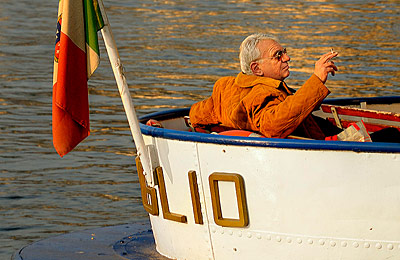 Image #19 … Lake Como Cruise … People are attracted to LIGHT and in particular, warm golden light. My subject has beautiful warm golden light across his face and jacket. COLOR is also a draw for the eye and in this scene the red of the Italian flag and the warm golden tone helps attract my audience into the picture. GESTURE or the moment is the completion of the formula. It is the waving of my subject’s arm while holding his cigarette and the posture he has, with chin raised that communicates to us his personality in a split second of time. Nikon D3s, ISO1000, 1/1500 at f10, Nikon 28-300mm VR Zoom Lens, WB 6700K, SanDisk 32G Extreme Pro Flash Card. Image #19 … Lake Como Cruise … People are attracted to LIGHT and in particular, warm golden light. My subject has beautiful warm golden light across his face and jacket. COLOR is also a draw for the eye and in this scene the red of the Italian flag and the warm golden tone helps attract my audience into the picture. GESTURE or the moment is the completion of the formula. It is the waving of my subject’s arm while holding his cigarette and the posture he has, with chin raised that communicates to us his personality in a split second of time. Nikon D3s, ISO1000, 1/1500 at f10, Nikon 28-300mm VR Zoom Lens, WB 6700K, SanDisk 32G Extreme Pro Flash Card. |
 Image #20 … Amore’ … Beautiful LIGHT, a splash of COLOR in her scarf, and the GESTURE of love…..”that’s amore”. Nikon D3s, ISO1000, 1/400 at f11, Nikon 28-300mm VR Zoom Lens, WB 6700K, SanDisk 32G Extreme Pro Flash Card. Image #20 … Amore’ … Beautiful LIGHT, a splash of COLOR in her scarf, and the GESTURE of love…..”that’s amore”. Nikon D3s, ISO1000, 1/400 at f11, Nikon 28-300mm VR Zoom Lens, WB 6700K, SanDisk 32G Extreme Pro Flash Card. |






















